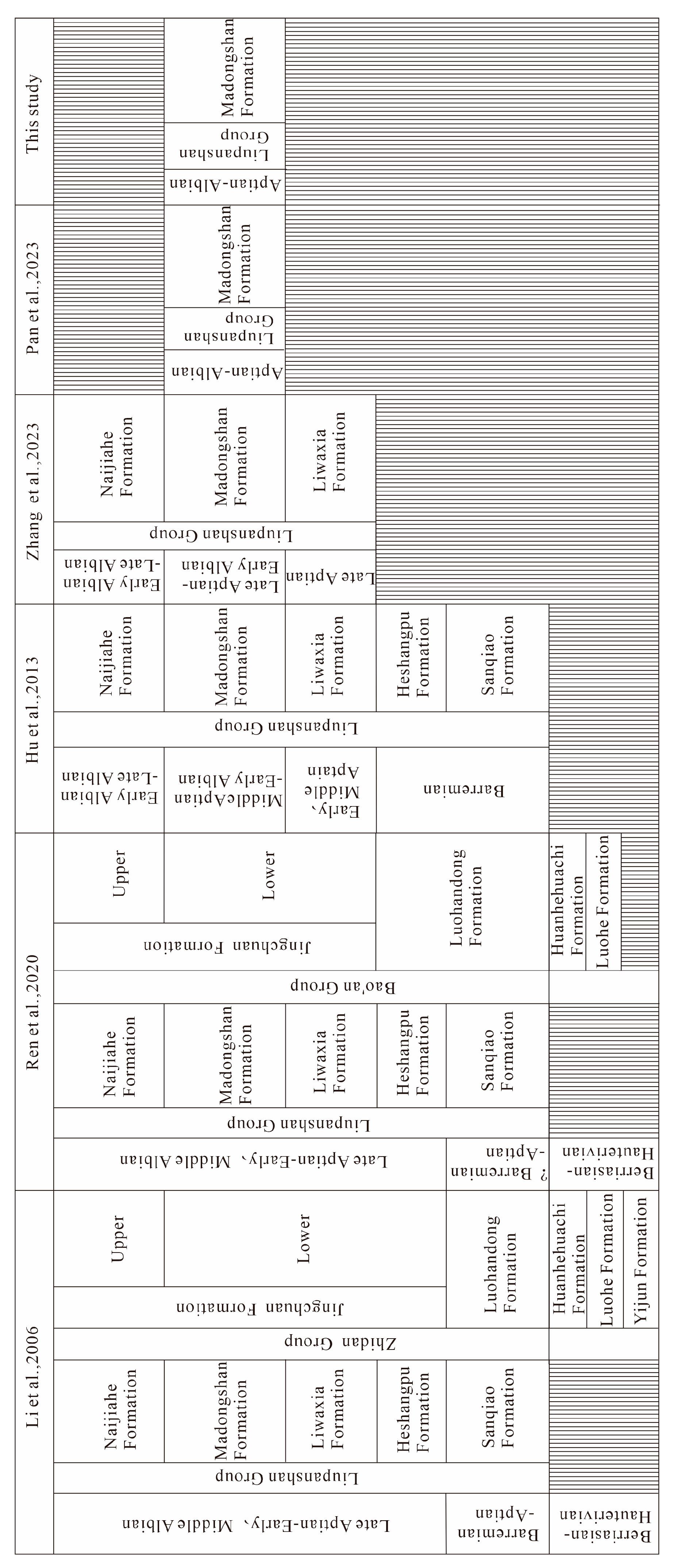Response of Cretaceous Palynological Records to Regional Tectonic Events and Global Climate Change in Liupanshan Basin, Northwest China
Abstract
1. Introduction
2. Geological Background
3. Material and Methods
3.1. Sample Material
3.2. Methods
4. Results
4.1. Zone I: Classopollis-Araucariacites Assemblage (62.9–44.6 m)
4.2. Zone II: Classopollis-Araucariacites-Bisaccates Assemblage (44.6–18.5 m)
4.3. Zone III: Araucariacites-Classopollis-Jiaohepollis Assemblage (18.5–0 m)
5. Discussion
5.1. Response of Structural Events to Paleoclimate Evolution
5.1.1. Ages of the Haijiazhuang Section
5.1.2. Regional Stratigraphic Comparison
5.2. Paleovegetation and Paleoclimatic Evolution
5.3. Paleoclimatic Responses to Regional Tectonic and Global Climatic Events
5.3.1. Responses to Regional Tectonic Events
5.3.2. Responses to Global Climatic Events
6. Conclusions
Author Contributions
Funding
Data Availability Statement
Acknowledgments
Conflicts of Interest
References
- Yu, H.T.; Xu, Z.J.; Cheng, R.H.; Wang, L.L.; Gao, D.; Hu, X.Q.; Zhang, Z. Paleoclimate Evolution and Elemental Geochemical Response during Middle Jurassic-Early Cretaceous in Tectonic Regime Transition Period in the North Yellow Sea Basin. Earth Sci. 2021, 46, 1100–1118, (In Chinese with English Abstract). [Google Scholar]
- Cai, X.Y.; Zhang, Z.L.; Li, Q.J.; Li, Y. Microfossil assembleges throughout the Late Jurassic to early Cretaceous from well Haican-1, Liupanshan Basin, Ningxia, NW China. Acta Micropalaeontol. Sin. 2010, 27, 60–66, (In Chinese with English Abstract). [Google Scholar]
- Du, B.X.; Zhang, M.Z.; Dai, S.; Sun, B.N. Discovery of Pseudofrenelopsis from the Lower Cretaceous of Liupanshan Basin and its paleoclimatic significance. Cretac. Res. 2014, 48, 193–204. [Google Scholar] [CrossRef]
- He, X.; Chen, Z.Q.; Lu, Z.S.; Li, J.; Hu, W.; Li, S.F.; Xu, Z.T. Exceptionally preserved caddisfly larval cases (Insecta) from the lower Cretaceous of the Liupanshan basin, Western China. J. Earth Sci. 2015, 26, 192–202. [Google Scholar] [CrossRef]
- Zhao, X.C.; Liu, C.Y.; Wang, J.Q.; Luo, W.; Du, F.P.; Ma, L. Provenance Analyses of Lower Cretaceous Strata in the Liupanshan Basin: From Paleocurrents Indicators, Conglomerate Clast Compositions, and Zircon U-Pb Geochronology. J. Earth Sci. 2020, 31, 757–771. [Google Scholar] [CrossRef]
- He, D.F. Multi-cycle superimposed sedimentary basins in China: Formation, evolution, geologic ramework and hydrocarpon occurrence. Earth Sci. Front. 2022, 29, 24–59, (In Chinese with English Abstract). [Google Scholar]
- Zhao, Y.; Xu, G.; Zhang, S.H.; Yang, Z.Y.; Zhang, Y.Q.; Hu, J.M. Yanshan Movement and the transformation of East Asian tectonic system. Earth Sci. Front. 2004, 11, 319–328. (In Chinese) [Google Scholar]
- Dong, S.W.; Zhang, Y.Q.; Long, C.X.; Yang, Z.Y.; Ji, Q.; Wang, T.; Hu, J.M.; Chen, X.H. Jurassic Tectonic Revolution in China and New Interpretation of the Yanshan Movement. Acta Geol. Sin. 2007, 82, 1449–1461, (In Chinese with English Abstract). [Google Scholar]
- Liu, C.Y.; Zhao, H.G.; Gui, X.J.; Yue, L.P.; Zhao, J.F.; Wang, J.Q. Space-Time Coordinate of the Evolution and Reformation and Mineralization Response in Ordos Basin. Acta Geol. Sin. 2006, 80, 617–638, (In Chinese with English Abstract). [Google Scholar]
- Zhang, Y.Q.; Shi, W.; Liao, C.Z.; Hu, B. Fault Kinematic Analysis and Change in Late Mesozoic Tectonic Stress Regimes in the Peripheral Zones of the Ordos Basin, North China. Acta Geol. Sin. 2006, 80, 639–647, (In Chinese with English Abstract). [Google Scholar]
- Cheng, Y.Z.; Shi, W.; Zhao, G.C.; Wang, T.Y.; Yang, Q.; Qin, X.; Zhang, Y.; Liu, X.B. Superimposed Deformation Analysis in Kexueshan Area, the Western Periphery of Ordos Block, China. J. Earth Sci. Environ. 2019, 41, 209–224, (In Chinese with English Abstract). [Google Scholar]
- Wu, C.; Wang, Y.; Yuan, W.M.; Zhou, L.Y. A Complex Meso-Cenozoic History of Far-Field Extension and Compression: Evidence from Fission Track Analysis in the Helanshan Mountain Tectonic Belt, NW China. Appl. Sci. 2024, 14, 3559. [Google Scholar] [CrossRef]
- Zheng, D.W.; Zhang, P.Z.; Wan, J.L.; Yuan, D.Y.; Zhang, G.L.; Li, C.Y. Apatite fission track evidence for the thermal history of the Liupanshan basin. Chin. J. Geophys. 2005, 48, 157–164. (In Chinese) [Google Scholar] [CrossRef]
- Zhao, H.G.; Liu, C.Y.; Wang, F.; Wang, J.Q.; Li, Q.; Yao, Y.M. Uplifting time and evolution of Helan Mountain. Sci. Sin. (Terrae) 2007, 37, 185–192. (In Chinese) [Google Scholar]
- Chen, Y.; Li, J.G.; Miao, P.S.; Chen, L.L.; Zhao, H.L.; Wang, C.; Yang, J. Relationship between the tectono-thermal events and sandstone-type uranium mineralization in the southwestern Ordos Basin, Northern China: Insights from apatite and zircon fission track analyses. Ore Geol. Rev. 2022, 143, 104792. [Google Scholar] [CrossRef]
- Hu, H.F.; Dai, S. Early Cretaceous Magnetostratigraphy of Liupanshan Area and Its Tectonic lmplications. Geoscience 2013, 27, 278–287, (In Chinese with English Abstract). [Google Scholar]
- Peng, H.; Liu, X.Y.; Liu, C.Y.; Hui, X.; Quan, X.Y.; Zhang, T.B.; Zhao, H.G.; Wang, J.Q. Spatial-temporal evolution and the dynamic background of the translation of Mid-Late Mesozoic tectonic regimes of the southwest Ordos basin margin. Acta Geol. Sin. 2022, 96, 387–402, (In Chinese with English Abstract). [Google Scholar]
- Tian, Z.Y.; Chen, H.; Liu, X.S.; Gong, W.B.; Zhao, W.B.; Kang, R. Fission track ages and Mesozoic tectonic uplift in the Niushoushan-Luoshan area on the western edge of the Ordos Basin. J. Geomech. 2023, 29, 599–617, (In Chinese with English Abstract). [Google Scholar]
- Zhang, M.Z.; Dai, S.; Zhang, X.W.; Wang, S.; Du, Z.; Ma, B.; Du, B.X. Conifer-dominant palynoflora from the Lower Cretaceous in Ordos Basin, China: Biostratigraphical and palaeoclimatic implications. Geol. J. 2020, 56, 1549–1563. [Google Scholar] [CrossRef]
- Li, Z.H.; Dong, S.W.; Feng, S.B.; Qu, H.J. Sedimentary Response to Middle-Late Jurassic Tectonic Events in the Ordos Basin. Acta Geosci. Sin. 2015, 36, 22–30, (In Chinese with English Abstract). [Google Scholar]
- Li, W.; Jiang, D.Z.; Dong, Y.P.; Zheng, Z.X.; Zhao, J.X.; Kang, W.B.; Zhang, L. Mesozoic contractional deformation in central East Asia: Constraints from deformation and sedimentary record of the Helanshan fold and thrust belt, North China Craton. Gondwana Res. 2022, 107, 235–255. [Google Scholar] [CrossRef]
- Liu, Z.Q.; Ma, L.Y.; He, X.Y.; Wen, L.F.; Tang, Y.; Zheng, R.C.; Ren, Y.T.; Luo, X. Tectonic Deformation Sequence, Critical Tectonic Periods and Characteristics in Dongsheng Gas Field, Ordos Basin. China Earth Sci. 2023, 48, 533–552, (In Chinese with English Abstract). [Google Scholar]
- Sahagian, D.; Pinous, O.; Olferiev, A.; Zakharov, V. Eustatic curve for the Middle Jurassic-Cretaceous based on Russian Platform and Siberian stratigraphy: Zonal resolution. AAPG Bull. 1996, 80, 1433–1458. [Google Scholar]
- Clarke, L.J.; Jenkyns, H.C. New oxygen isotope evidence for long-term Cretaceous climatic change in the Southern Hemisphere. Geology 1999, 27, 699–702. [Google Scholar] [CrossRef]
- Dong, X.P.; Li, Z.H.; Huang, T.; Jiang, B.Y.; Cui, J.W. Origin of the Latent Palaeohigh in Hongsibu Basin of Ningxia, China and its Effect on the Regional Desertification. J. Earth Sci. Environ. 2020, 42, 688–700, (In Chinese with English Abstract). [Google Scholar]
- Liu, B.H.; Wu, F.; Zhang, X.J.; Cui, J.W.; Dong, X.P. Elemental geochemical characteristics and environmental significance of Late Pleistocene sediments in the Hongsibu Basin, northeastern margin of the Tibetan Plateau. Geol. Bull. China 2024, 43, 33–45, (In Chinese with English Abstract). [Google Scholar]
- Wu, F.; Ma, J.; Liu, B.H.; Wang, J.; Shi, B.Y.; Zhang, Y.L.; Xie, F. Water resources characteristics in the Qianzhuang Area, west edge of the LiupanMountains: Suggestions for development and utilization. Water Resour. Hydropower Engi. 2023, 54, 49–58, (In Chinese with English Abstract). [Google Scholar]
- Cui, H.J.; Wang, J.D.; Yin, K.M.; Zhao, H.H. Charcteristics of sedimentary evolution of Early Cretaceous in Liupanshan Basin. J. Xi’an Univ. Sci. Technol. 2013, 33, 411–416, (In Chinese with English Abstract). [Google Scholar]
- Pan, J.L.; Li, Z.H.; Ma, J.; Shi, B.Y.; Xie, F.; Ma, R.Y.; Zhang, F.F.; Zhang, Y.Y. Characteristics of sporopollen assemblages from Madongshan formation in Liupanshan Area of Ningxia, China and Their Indicative Significance to thepaleoclimate of the age of dinosaurs. J. Earth Sci. Environ. 2023, 45, 279–293, (In Chinese with English Abstract). [Google Scholar]
- Liu, S.F.; Su, S.; Zhang, G.W. Early Mesozoic Basin Development in North china: Indicaions of Cratonic Deformationy. J. Asian Earth Sci. 2013, 62, 221–236. [Google Scholar] [CrossRef]
- Ningxia Hui Autonomous Region Geological Survey Institute. Regional Geology of China-Annals of Ningxia; Geological Publishing House: Beijing, China, 2017. (In Chinese) [Google Scholar]
- Ren, W.X.; Hu, Y.X.; Yang, T.; Sun, B.N. Palynological assemblage and stratigraphic significance of Baoan group in Longdong area of Ordos Basin. J. Lanzhou Univ. (Nat. Sci.) 2020, 56, 444–452, (In Chinese with English Abstract). [Google Scholar]
- Zhang, M.Z.; Dai, S.; Jin, P.H.; Liu, J.W.; Huang, Y.B.; Jiaoba, D.Z.; Li, A.J. Long-term arid and hot climate during early Mid-Cretaceous indicate by unvaried Cheirolepidiaceae-dominant palynoflora from the Liupanshan Basin, China. Geol. J. 2023, 58, 3899–3914. [Google Scholar] [CrossRef]
- Liu, C.H.; Li, Z.Y.; He, F.; Zhang, Z.L.; Li, Z.C.; Ling, M.X.; Liu, R.P. Ouantitative analysis of provenance in the Lower Cretaceous of the northwestern Ordos Basin. Earth Sci. Front. 2024, 31, 80–99, (In Chinese with English Abstract). [Google Scholar]
- Li, Z.H.; Dong, X.P.; Cui, J.W.; Huang, T.; Kou, L.L. Mesocenozoic Tectonic Evolution of the Western Margin and Peripheral Basins of Ordos Basin; Institute of Geomechanics, Chinese Academy of Geological Sciences: Beijing, China, 2021. (In Chinese) [Google Scholar]
- Ma, J.; Xie, F.; Shi, B.Y.; Wang, Z.W.; Wang, D.; Du, P.L.; Wang, H.B.; Yun, W.Q.; Zhang, W.J. Characteristics and geological significance of the palynological assemblages of the Qingshuiying formation in the Beilianchi section, northeastern margin of the Tibetan Plateau. J. Geomech. 2023, 29, 555–568, (In Chinese with English Abstract). [Google Scholar]
- Wei, L.J.; Li, Z.H.; Dong, X.P.; Cui, J.W.; Huang, T.; Kou, L.L. Palynological Evidence of Late Pleistocene Soft-sediment Deformation Event in the Northeastern Margin of the Tibetan Plateau. Acta Geol. Sin. Engl. 2023, 97, 841–854. [Google Scholar] [CrossRef]
- Srivastava, S.K. The fossil pollen genus Classopollis. Lethaia 1976, 9, 437–457. [Google Scholar] [CrossRef]
- Vakhrameev, V.A. Pollen Classopolis: Indicator of Jurassic and Cretaceous climates. J. Palaeosci. 1981, 28, 301–307. [Google Scholar] [CrossRef]
- Ren, W.X.; Hu, B.; Tang, D.L.; Wu, J.Y.; Sun, B.N. Palynological assemblage and its significance of the Lower Cretaceous Chiinbao Formationin the Zhongkouzi Basin, Beishan area. Earth Sci. 2024, 40, 1234–1249, (In Chinese with English Abstract). [Google Scholar]
- Zhang, M.Z.; Dai, S.; Zhang, Y.Q.; Miao, Y.F.; Liu, J.W.; Huang, Y.B.; Zhao, J.; Liu, X. Early Cretaceous palynological assemblage and its environmental significance in the sediments of Liupanshan Group (Sikouzi section), Liupanshan Region, central China. Arid Land Geogr. 2012, 35, 99–108, (In Chinese with English Abstract). [Google Scholar]
- Ren, W.X.; Zhao, H.J.; Hu, Y.X.; Sun, B.N. Early Cretaceous sporopollen assemblage and stratigraphic significance in southwestern margin of Ordos basin. Geol. Rev. 2019, 65, 129–131, (In Chinese with English Abstract). [Google Scholar]
- Li, M.Q.; Li, J.G. Late Jurassic-Early Cretaceous palynofloras in the Lhasa Block, central Xizang, China and their bearing on palaeoenvironments. Palaeogeogr. Palaeoclimatol. Palaeoecol. 2019, 515, 95–106. [Google Scholar]
- Batten, D.J. Upper Jurassic and Cretaceous miospores. In Palynology: Principles and Applications; 1996; Chapter 20E; pp. 807–830. Available online: https://www.researchgate.net/publication/275256769_Upper_Jurassic_and_Cretaceous_miospores (accessed on 10 May 2025).
- Li, J.G.; Peng, J.G.; Zhang, Q.Q. Palynological Assemblages from the Cretaceous succession at Chaqiela, Gamba county, Xizang. Acta Palaeontol. Sin. 2016, 55, 346–366, (In Chinese with English Abstract). [Google Scholar]
- Chen, H.M.; Ma, T.Q. The discovery of Early Cretaceous spore- pollen assemblage in the Middle Jurassic strata of the Rucheng Basin, Hunan Province. Geol. Bull. China. 2016, 35, 1985–1989, (In Chinese with English Abstract). [Google Scholar]
- Zhang, Z.F.; Miao, S.J. Palynology of Zhidan Group in Huating-Longxian area, southwest Ordos Basin. Northwest Geosci. 1989, 25, 69–96. (In Chinese) [Google Scholar]
- Muller, J. Palynological Evidence on Early Differentiation of Angiosperms. Biol. Rev. 1970, 45, 417–450. [Google Scholar] [CrossRef]
- Li, J.G.; Du, B.A. Palynophytes of the Cretaceous Liupanshan Group in Anguo Town, Pingliang, Gansu Province. Acta Palaeontol. Sin. 2006, 4, 487–497. (In Chinese) [Google Scholar]
- Shaanxi Geological and Mineral Bureau. Regional Geology of China-History of Shaanxi; Geological Publishing House: Beijing, China, 2017. (In Chinese) [Google Scholar]
- Xu, Z.L.; Wei, G.L.; Zeng, H.; Li, H.L.; Li, J.G.; Zhu, Q.; Zhang, B.; Cao, M.Q. Late Cretaceous palynological assemblage and its palaeoclimate record from Yaojia formation in Qianjiadian depression, Kailu basin. Earth Sci. 2017, 42, 1725–1735, (In Chinese with English Abstract). [Google Scholar]
- Xu, Z.L.; Cheng, Y.H.; Ao, C.; Zhang, T.F.; Wang, S.Y. Middle Jurassic palaeoclimate changes within the central Ordos Basin based on palynological records. Palaeobio. Palaeoenv. 2022, 103, 21–42. [Google Scholar] [CrossRef]
- Sun, L.X.; Zhang, Y.; Zhang, T.F.; Cheng, Y.H.; Li, Y.F.; Ma, H.L.; Yang, C.; Guo, J.C.; Lu, C.; Zhou, X.G. Jurassic sporopollen of Yan’an Formation and Zhiluo Formation in the northeastern OrdosBasin, Inner Mongolia, and its paleoclimatic significance. Earth Sci. Front. 2017, 24, 32–51, (In Chinese with English Abstract). [Google Scholar]
- Xie, Y.L.; Wu, F.L.; Fang, X.M.; Song, J.Z.; Niu, Z.C. Late Eocene onset of the East Asian Monsoon in the Qingjiang Basin of Central Jiangxi Province (Southeast China) revealed by a major vegetation transition from desert to forest. Palaeogeogr. Palaeoclimatol. Palaeoecol. 2022, 602, 111179. [Google Scholar] [CrossRef]
- Huang, L.; Zhang, X.J.; Li, G.Z.; Ji, X.K.; Han, X.; Wang, Z.Y.; Liu, Z.Q.; Hou, Z.M.; Ai, Z.H. Sporopollen assemblage from the Middle Jurassic of the northeastern Ordos basin, Inner Mongolia, and their paleoclimatic implications. Acta Geol. Sin. 2023, 97, 1390–1406, (In Chinese with English Abstract). [Google Scholar]
- Huang, P.; Zhang, G.F. Sporopollen assemblage from the Dalazi formation of the Zhixin Basin, Jilin. Acta Micropalaeontol. Sin. 2002, 19, 263–275, (In Chinese with English Abstract). [Google Scholar]
- Li, K.Y.; Li, W.H.; Liu, Z.; Zhang, D.Y. Characteristics of Early Cretaceous prototype basin of Liupanshan Group in Liupanshan Basin. Geol. Bull. China. 2016, 35, 383–389, (In Chinese with English Abstract). [Google Scholar]
- Li, X.B.; Zhang, Y.; Tong, Y.B. Preliminary analysis on the paleogeography and paleoenvironment in the eastern Yanliaoarea during the Jurassic-Cretaceous tectonic transition. Earth Sci. Front. 2021, 28, 391–411. [Google Scholar]
- Jia, J.L.; Miao, C.S.; Xie, W.Q. Terrestrial paleoclimate transition associated with continental weathering and drift during the Aptian-Albian of East Asia. Bulletin 2023, 135, 467–480. [Google Scholar] [CrossRef]
- Zhang, Q.; Wang, Y.L.; Jin, W.J.; Li, C.D. The Eastern Plateau of China in the Late Mesozoic: Evidence, problems, and implications. Geol. Bull. China 2008, 27, 1404–1430, (In Chinese with English Abstract). [Google Scholar]
- Zhang, Q.; Jin, W.J.; Wang, Y.L.; Li, C.D.; Jia, X.Q. Discussion of north boundary of the East China Plateau during late Mesozoic Era. Acta Petrol. Sin. 2007, 23, 689–700, (In Chinese with English Abstract). [Google Scholar]
- Kemper, E. Ṹber Kalt und Warmzeiten der Unterkreide. Zit-Teliana 1983, 10, 359–369. [Google Scholar]
- De Lurio, J.L.; Frakes, L.A. Glendonites as a paleoenvironmentaltool: Lmplications for early Cretaceous high lattude climates in Australiall. Geochim. Cosmochim. Acta 1999, 63, 1034–1048. [Google Scholar] [CrossRef]
- McAnena, A.; Flögel, S.; Hofmann, P.; Herrle, J.O.; Griesand, A.; Pross, J.; Talbot, H.M.; Rethemeyer, J.; Wallmann, K.; Wagner, T. Atlantic cooling associated with a marine biotic crisis during the mid-Cretaceous period. Nat. Geosci. 2013, 6, 558–561. [Google Scholar] [CrossRef]
- Haq, B.U.; Hardenbol, J.; Vail, P.R. Chronology of fluctuating sealevels since the Triassic. Science 1987, 235, 1156–1167. [Google Scholar] [CrossRef] [PubMed]
- Kear, B.P. Marine reptiles from the Lower Cretaceous (Aptian) deposits of White Cliffs, southeastern Australia: Implications of a high latitude, cold water assemblage. Cretac. Res. 2005, 26, 769–782. [Google Scholar] [CrossRef]
- Ben Chaabane, N.; Khemiri, F.; Soussi, M.; Belhaj Taher, I. Late Aptian carbonate platform evolution and controls (south Tethys, Tunisia): Response to sea-level oscillations, palaeoenvironmental changes and climate. Facies 2021, 67, 26. [Google Scholar] [CrossRef]
- Basilone, L. Synsedimentary tectonics vs paleoclimatic changes across the Aptian-Albian boundary along the Southern Tethyan margin: The panormide carbonate platform case history (NW Sicily). Mar. Petrol. Geol. 2020, 124, 104801. [Google Scholar] [CrossRef]
- Suarez, M.B.; Ludvigson, G.A.; Gonzalez, L.A.; You, H.L. Continental paleotemperatures from an Early Cretaceous dolomitic lake, Gansu Province, China. J. Sediment. Res. 2017, 87, 486–499. [Google Scholar] [CrossRef]
- Harper, D.T.; Suarez, M.B.; Uglesich, J. Aptian-Albian clumped isotopes from Northwest China: Cool temperatures, valiable atmospheric pCO2 and regional shifts in the hydrologic cyclell. Clim. Past 2021, 17, 1607–1625. [Google Scholar] [CrossRef]
- De Araujo Carvalho, M.; Lana, C.C.; Bengtson, P.; de Paula Sá, N. Late Aptian (Cretaceous) climate changes in northeastern Brazil: A reconstruction based on indicator species analysis (IndVal). Palaeogeogr. Palaeoclimatol. Palaeoecol. 2017, 485, 543–560. [Google Scholar] [CrossRef]
- Herrle, J.O.; Schröder-Adams, C.J.; Davis, W.; Pugh, A.T.; Galloway, J.M.; Fath, J. Mid-Cretaceous High Arctic stratigraphy, climate, and Oceanic Anoxic Events. Geology 2015, 43, 403–406. [Google Scholar] [CrossRef]
- Wang, C.L.; Zhang, M.S.; Li, X.B.; Wang, Y.N. Early Cretaceous Palynological Assemblages of the Shuangliao Fault Depression, Songliao Basin and their Geological Implications. Acta Geol. Sin. Engl. 2017, 91, 1949–1963. [Google Scholar] [CrossRef]
- Wang, J.Y.; Li, X.H.; Li, L.Q.; Wang, Y.D. Cretaceous climate variations indicated by palynoflora in South China. Palaeoworld 2022, 31, 507–520. [Google Scholar] [CrossRef]
- Dou, L.R.; Zhang, X.S.; Xiao, K.Y.; Xi, D.P.; Du, Y.B.; Wang, L.; Hu, J.; Hu, Y.; Zheng, Q.Y. Early Cretaceous (Aptian to Albian) vegetation and climate change in Central Africa: Novel palynological evidence from the Doseo Basin. Geol. J. 2024, 59, 441–467. [Google Scholar] [CrossRef]
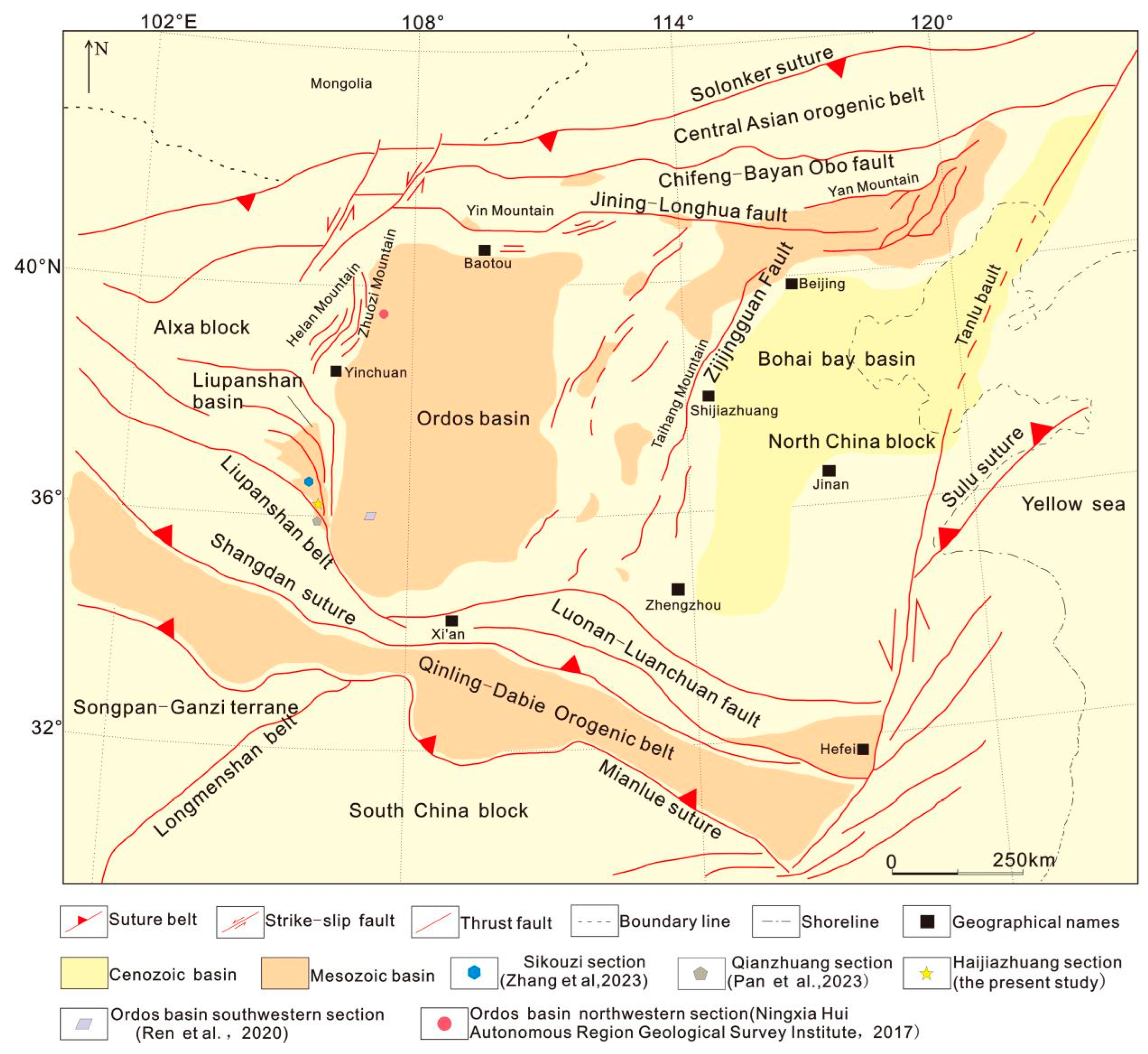
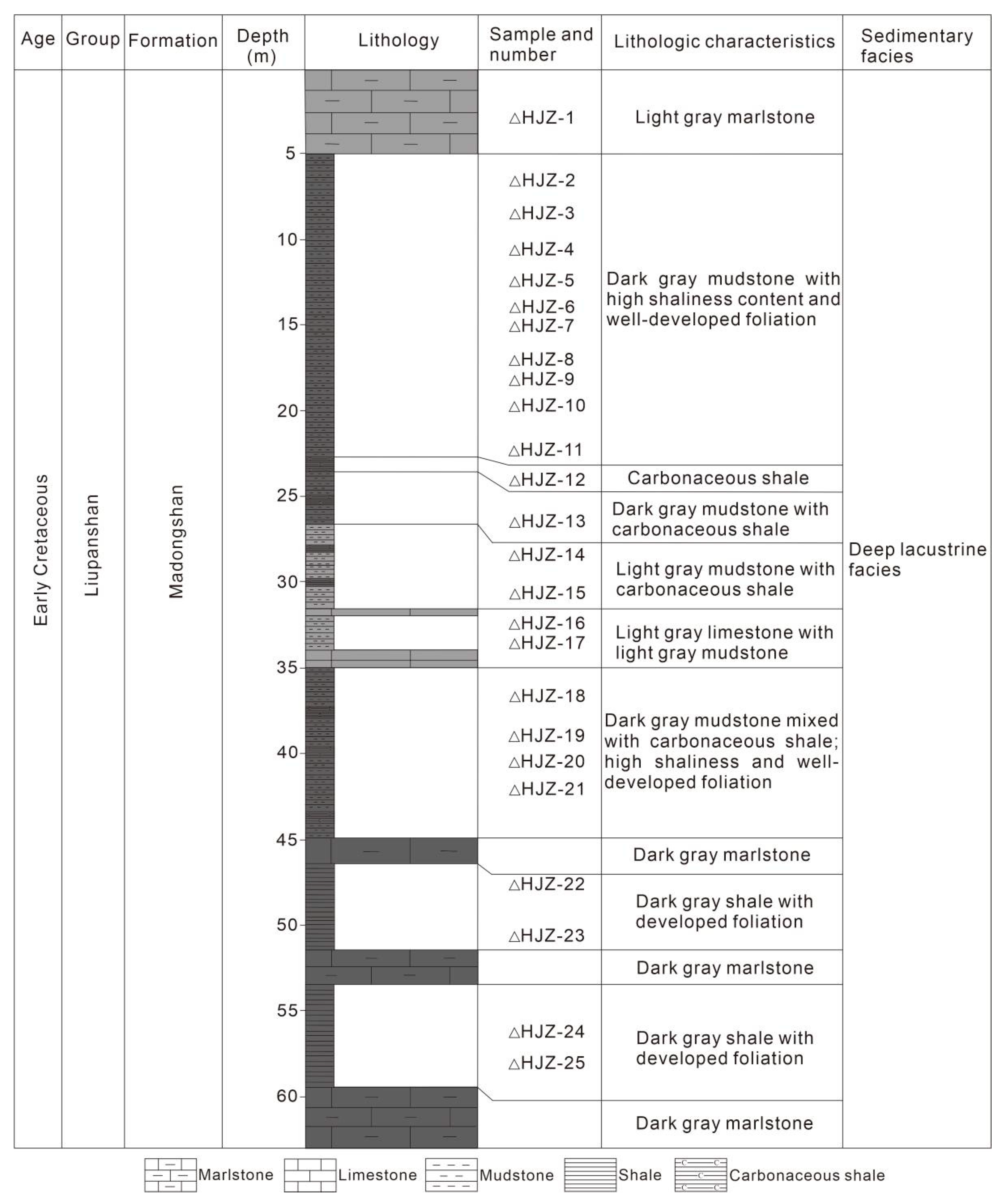
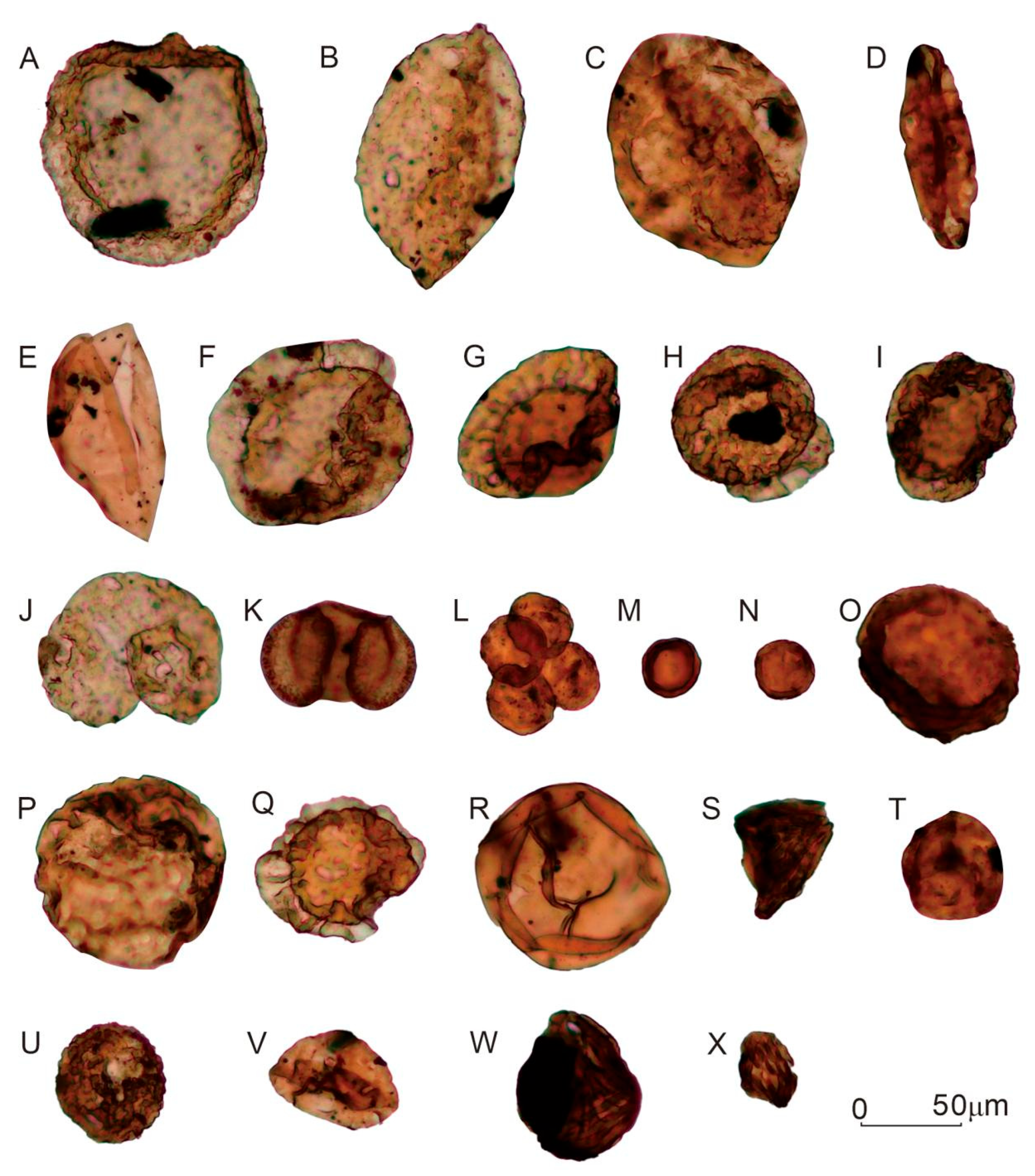
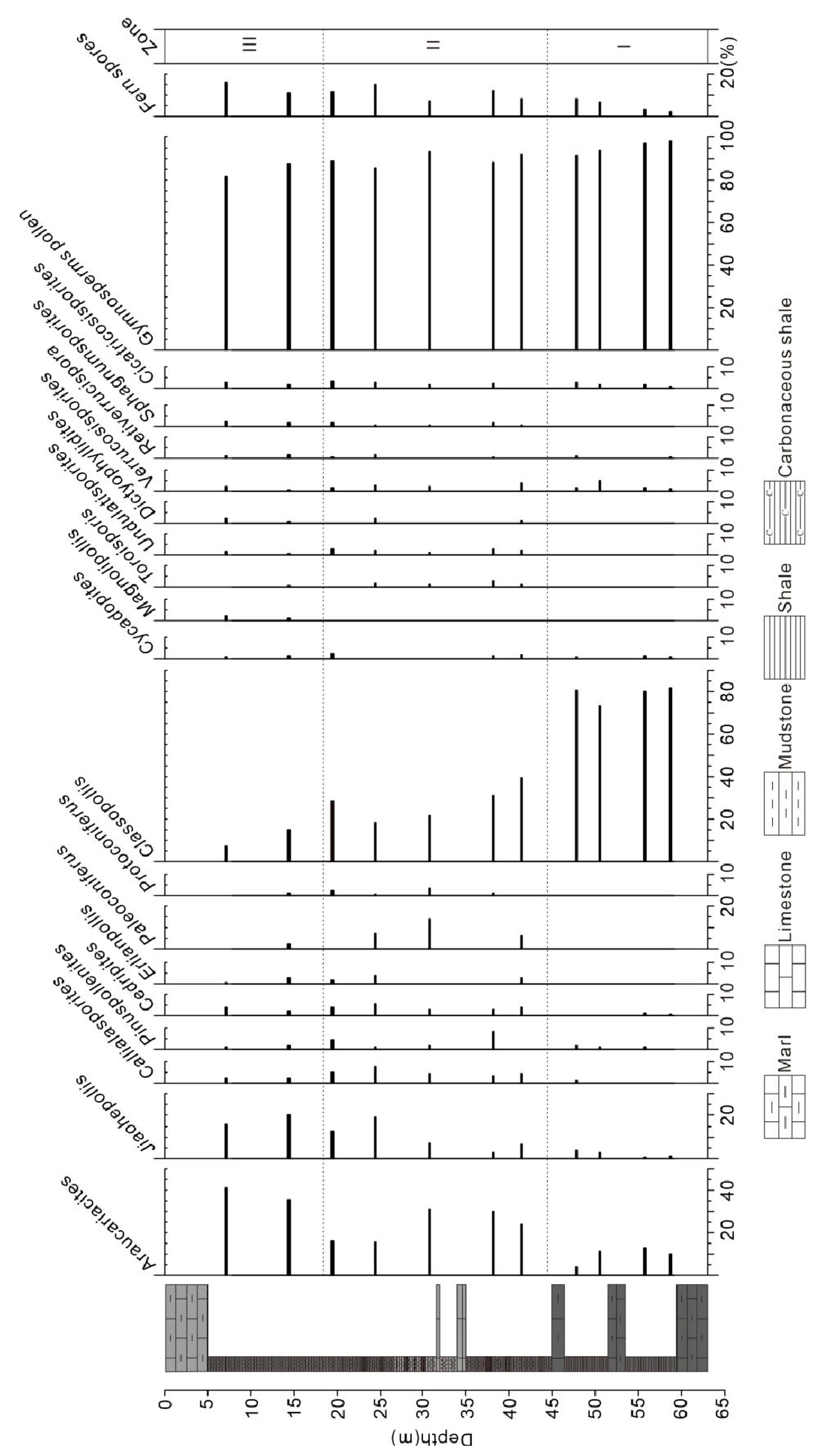
| Spore-Pollen Taxa or Category | Botanical Affinity | Ecological Type | Types of Climatic Zones | Vegetation Component |
|---|---|---|---|---|
| Dictyophyllidites | Dipteridaceae | hygrophytic | tropical-subtropical | shrub |
| Concavisporites | hygrophytic | tropical-subtropical | shrub | |
| Punctatisporites | Filicopsida | hygrophytic | tropical-temperate zone | Herb |
| Toroisporis | Osmundaceae | hygrophytic | tropical-subtropical | shrub |
| Cicatricosisporites | Lygodiaceae | hygrophytic | tropical | shrub |
| Appendicisporites | hygrophytic | tropical | shrub | |
| Sphagnumsporites | Sphagnaceae | hygrophytic | tropical | Herb |
| Undulatisporites | Ophioglossaceae | hygrophytic | tropical | Herb |
| Araucariacites | Araucariaceae | mesophytic | tropical-subtropical | conifer |
| Callialasporites | mesophytic | tropical-subtropical | conifer | |
| Psophosphaera | mesophytic | tropical-subtropical | conifer | |
| Jiaohepollis | mesophytic | tropical-subtropical | conifer | |
| Perinopollenites | Cupressaceae | mesophytic | temperate zone | conifer |
| Inaperturopollenites | mesophytic | temperate zone | conifer | |
| Podocarpidites | Podocarpaceae | mesophytic | tropical-subtropical | conifer |
| Classopollis | Cheirolepidiaceae | xerophytic | tropical-subtropical | conifer |
| Cedripites | Pinaceae | mesophytic | tropical-temperate zone | conifer |
| Pinuspollenites | mesophytic | tropical-temperate zone | conifer | |
| Piceaepollienties | mesophytic | tropical-temperate zone | conifer | |
| Abiespollenties | mesophytic | tropical-temperate zone | conifer | |
| Erlianpollis | mesophytic | tropical-temperate zone | conifer | |
| Paleoconiferus | Coniferales | mesophytic | temperate zone | conifer |
| Protoconiferus | mesophytic | temperate zone | conifer | |
| Protopinus | mesophytic | temperate zone | conifer | |
| Cycadopites | Cycadaceae | mesophytic | tropical | broadleaved trees |
| Ginkgoretectina | Ginkgoaceae | mesophytic | temperate zone | broadleaved trees |
| Verrucosisporites | Uncertain | - | - | - |
| Retiverrucispora | Uncertain | - | - | - |
| Region | Climate Reference | Climate Significance | Period |
|---|---|---|---|
| Sverdrup Basin, Canadian Arctic, and Spitsbergen, Norway | glendonites | The sea water temperature is close to the freezing point. | Late Aptian |
| North Atlantic | TEX86 | The surface temperature of the ancient seawater dropped significantly. | Late Aptian |
| Southeast Australia | Fossils of marine reptiles in high-latitude regions | The paleoclimate conditions during this period were extremely cold seasonally to near freezing point. | Late Aptian |
| Exmouth Plateau, Australia | δ18O > 0.8‰ | The temperature of seawater has decreased. | Aptian-Albian boundary |
| Global | The sea level curve is declining. | The temperature of seawater has decreased. | Aptian-Albian boundary |
| Region | Main Spores and Pollen Types | Indicated Climate | Period |
|---|---|---|---|
| Sergipe Basin, northeast Brazil | The Cheirolepidiaceae represented by Classopollis, transformed into ferns, and the Araucariaceae, represented by Araucariacites | humid | Late Aptian |
| Deseo Basin, central Africa | Hygrophilous species, such as Cyathidites, Cicatricosiporites, Callialaporites, Dictyophyllites, Osmundacidites, Araucariacites increased markedly | humid | Aptian-Albian boundary |
| Hefei Basin, China | Cupressaceae, Lygodiaceae, Araucariaceae | Warm and humid | Aptian-Albian boundary |
| Jianghan Basin, China | |||
| Jiansu Basin, China | |||
| Liupanshan Basin, China (this study) | The Cheirolepidiaceae represented by Classopollis, transformed into ferns and the Araucariaceae represented by Araucariacites | humid | Aptian-Albian boundary |
Disclaimer/Publisher’s Note: The statements, opinions and data contained in all publications are solely those of the individual author(s) and contributor(s) and not of MDPI and/or the editor(s). MDPI and/or the editor(s) disclaim responsibility for any injury to people or property resulting from any ideas, methods, instructions or products referred to in the content. |
© 2025 by the authors. Licensee MDPI, Basel, Switzerland. This article is an open access article distributed under the terms and conditions of the Creative Commons Attribution (CC BY) license (https://creativecommons.org/licenses/by/4.0/).
Share and Cite
Liu, B.; Wu, F.; Wei, L.; Li, Z.; Dong, X. Response of Cretaceous Palynological Records to Regional Tectonic Events and Global Climate Change in Liupanshan Basin, Northwest China. Appl. Sci. 2025, 15, 5900. https://doi.org/10.3390/app15115900
Liu B, Wu F, Wei L, Li Z, Dong X. Response of Cretaceous Palynological Records to Regional Tectonic Events and Global Climate Change in Liupanshan Basin, Northwest China. Applied Sciences. 2025; 15(11):5900. https://doi.org/10.3390/app15115900
Chicago/Turabian StyleLiu, Bohua, Fang Wu, Lijie Wei, Zhenhong Li, and Xiaopeng Dong. 2025. "Response of Cretaceous Palynological Records to Regional Tectonic Events and Global Climate Change in Liupanshan Basin, Northwest China" Applied Sciences 15, no. 11: 5900. https://doi.org/10.3390/app15115900
APA StyleLiu, B., Wu, F., Wei, L., Li, Z., & Dong, X. (2025). Response of Cretaceous Palynological Records to Regional Tectonic Events and Global Climate Change in Liupanshan Basin, Northwest China. Applied Sciences, 15(11), 5900. https://doi.org/10.3390/app15115900






